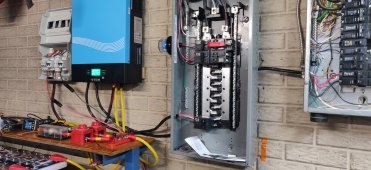khisanthax
New Member
The middle of this story is that I bought a 120v AIO when I needed a 240v split phase before better understanding what I was doing and what I needed. So, thank you to everyone who has patiently answered my questions and thanks to everyone who asked questions before me.
It looks like I'm going to get the SunGoldPower AIO inverter and wanted to ask if what I have and what I need to get, while maybe not optimal, will work safely. It has the following specs.
This is what I have now:
One lifepo4 48v 50AH battery. Based on this recommendation I'll have to replace my current 4awg battery cables with 2awg battery cables.
8 eco-worthy 195w panels with the following specs:
vmp 19v
Voc 22.8v
Isc 12.23A
Imp 10.27A
I know the panels are not the best in many ways but I already bought them so I'll use them for now and will probably put them on a different scc and get panels with better watt/dollar later on. I will add one more eco worthy panel just to round out to 9 because of how they're placed on the roof so it looks symmetrical. Based on this recommendation I'll have to replace my current 12awg panel cables with 10awg. For the AC in and out it's recommending this but I currently have 6awg and plan to stick with those unless I shouldn't?
Now for fuses and circuit breakers. For the AC in I plan to use a double throw breaker rated at 50A for L1 and L2, I was going to use 60A but the manual says the rating of the AC transfer relay is 40A, did I understand this correctly? For AC out it's going to the subpanel in the garage that already has a 60A double throw, will that be fine? Between the battery and inverter because it states a charge rate of 120A so I should use a DC 150A breaker. Between the PV array and the Inverter I plan to use a DC 32A breaker. Am I missing or misunderstand anything?
It looks like I'm going to get the SunGoldPower AIO inverter and wanted to ask if what I have and what I need to get, while maybe not optimal, will work safely. It has the following specs.
This is what I have now:
One lifepo4 48v 50AH battery. Based on this recommendation I'll have to replace my current 4awg battery cables with 2awg battery cables.
8 eco-worthy 195w panels with the following specs:
vmp 19v
Voc 22.8v
Isc 12.23A
Imp 10.27A
I know the panels are not the best in many ways but I already bought them so I'll use them for now and will probably put them on a different scc and get panels with better watt/dollar later on. I will add one more eco worthy panel just to round out to 9 because of how they're placed on the roof so it looks symmetrical. Based on this recommendation I'll have to replace my current 12awg panel cables with 10awg. For the AC in and out it's recommending this but I currently have 6awg and plan to stick with those unless I shouldn't?
Now for fuses and circuit breakers. For the AC in I plan to use a double throw breaker rated at 50A for L1 and L2, I was going to use 60A but the manual says the rating of the AC transfer relay is 40A, did I understand this correctly? For AC out it's going to the subpanel in the garage that already has a 60A double throw, will that be fine? Between the battery and inverter because it states a charge rate of 120A so I should use a DC 150A breaker. Between the PV array and the Inverter I plan to use a DC 32A breaker. Am I missing or misunderstand anything?



